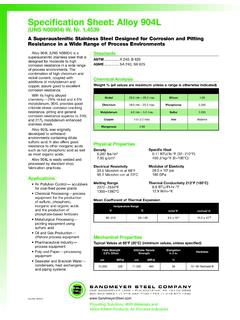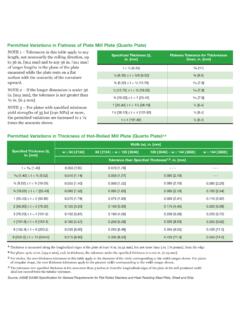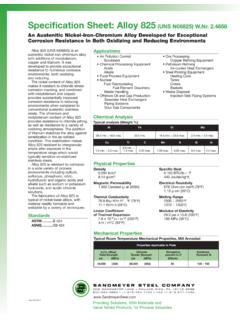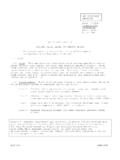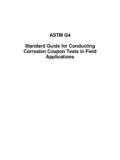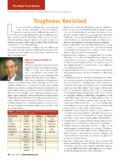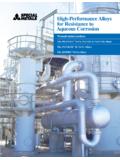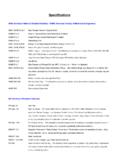Transcription of Specification Sheet: Alloy 321/321H - Sandmeyer Steel
1 Alloy 321 (UNS S32100) is a titanium stabilized austenitic stainless Steel with good general corrosion resistance. It has excellent resistance to intergranular corrosion after exposure to temperatures in the chromium carbide precipitation range of 800 1500 F (427 816 C). The Alloy resists oxidation to 1500 F (816 C) and has higher creep and stress rupture properties than alloys 304 and 304L. It also possesses good low temperature toughness. Alloy 321h (UNS S32109) is the higher carbon ( ) version of the Alloy . It was developed for enhanced creep resistance and for higher strength at temperatures above 1000 F (537 C). In most instances, the carbon content of the plate enables dual certification. Alloy 321 cannot be hardened by heat treatment, only by cold working. It can be easily welded and processed by standard shop fabrication Aerospace piston engine manifolds Chemical Processing Expansion Joints Food Processing equipment and storage Petroleum Refining polythionic acid service Waste Treatment thermal oxidizersStandardsASTM.
2 A 240 ASME ..SA 240 AMS ..5510 Chemical AnalysisWeight % (all values are maximum unless a range is otherwise indicated) Specification sheet : Alloy 321/321H (UNS S32100, S32109) W. Nr. Titanium Stabilized Austenitic Stainless Steel with Excellent Resistance to intergranular Corrosion After Exposure to Temperatures in the Chromium Carbide Precipitation Range of 800 1500 F (427 816 C) Alloy 321 06 Steel COMPANYONE Sandmeyer LANE PHILADELPHIA, PA 19116-3598800-523-3663 +1-215-464-7100 FAX +1-215-677-1430 Providing Solutions, With Materials andValue Added Products, for Process IndustriesPhysical PropertiesDensity lbs / in3 g /cm3 Modulus of Elasticity x 106 psi 193 GPaMelting Range 2550 2635 F 1398 1446 CSpecific Heat BTU/lb- F (32 212 F) 500 J/kg- K (0 100 C)Thermal Conductivity 212 F (100 C) BTU/hr/ ft2/ft / F W/m- KElectrical Resistivity 72 Microhm-cm at 20 CMechanical PropertiesTypical Values at 68 F (20 C)
3 Temperature Range F C in / in F cm /cm C 68 212 20 100 x 10-6 x 10-6 68 1112 20 600 x 10-6 x 10-6 68 1832 20 1000 x 10-6 x 10-6 Yield Strength Ultimate Tensile Elongation Hardness Offset Strength in 2 in. psi (min.) (MPa) psi (min.) (MPa) % (min.) (max.) 30,000 205 75,000 515 40 217 BrinellElement 321 321 HChromium min. max. min. min. max. min. min. Sulfur Silicon Titanium 5 x (C + N) min.
4 Max. 4 x (C + N) min. max. Nitrogen Iron Balance BalanceMean Coefficient of Thermal ExpansionThe information and data in this product data sheet are accurate to the best of our knowledge and belief, but are intended for informational purposes only, and may be revised at any time without notice. Applications suggested for the materials are described only to help readers make their own evaluations and decisions, and are neither guarantees nor to be construed as express or implied warranties of suitability for these or other COMPANYC orrosion ResistanceAlloy 321 exhibits good general corrosion resistance that is comparable to 304. It was developed for use in the chromium carbide precipitation range of 1800 1500 F (427 816 C) where un-stabilized alloys such as 304 are subject to intergranular attack.
5 The Alloy can be used in most diluted organic acids at moderate temperatures and in pure phosphoric acid at lower temperatures and up to 10% diluted solutions at elevated temperatures. Alloy 321 resists polythionic acid stress corrosion cracking in hydrocarbon service. It can also be utilized in chloride or fluoride free caustic solutions at moderate temperatures. Alloy 321 does not perform well in chloride solutions, even in small concentrations, or in sulfuric acid Data Alloy 321 can be easily welded and processed by standard shop fabrication The cold work hardening rate of 321 makes it less machinable than 410 stainless Steel , but similar to 304. The table below provides relevant machining Forming Working temperatures of 2100 2300 F (1149 1260 C) are recommended for forging, upsetting and other hot working processes. Do not work this Alloy at temperatures below 1700 F (927 C).
6 Material must be water quenched or fully annealed after working to re-attain maximum corrosion Forming The Alloy is quite ductile and forms easily. Welding Alloy 321 can be readily welded by most standard processes. A post weld heat treatment is not Tool LubricationOperationCuttingDrillingMilli ng ProfilingHigh Speed SteelCarbideCutting OilDry or Cutting OilHigh Speed SteelHigh Speed SteelHigh Speed SteelCutting OilCutting OilCutting OilTurning Depth-mm Depth-in Feed-mm/t Feed-in/t Speed-m/min Speed-ft/min 6 .23 .019 12 16 39 52 3 .11 .016 18 23 59 75 1 .04 .008 23 28 75 92 6 .23 .019 67 76 220 249 3 .11 .016 81 90 266 295 1 .04 .008 99 108 325 354 Depth of cut-m Depth of cut-in Feed-mm/t Feed-in/t Speed-m/min Speed-ft/min .06 .0012.
7 0020 16 21 52 69 3 .11 .0016 .0024 17 22 56 72 6 .23 .0020 .0027 18 23 59 75 Drill mm Drill in Feed-mm/t Feed-in/t Speed-m/min Speed-ft/min .06 .0007 .0012 9 13 29 42 3 .11 .0020 .0024 11 15 36 49 6 .23 .0031 .0035 11 15 36 49 12 .48 .0035 .0039 11 15 36 49 Feed-mm/t Feed-in/t Speed-m/min Speed-ft/min .002 .004 11 21 36 69





